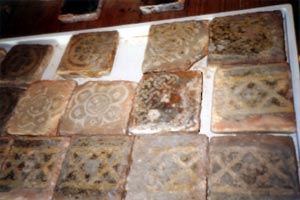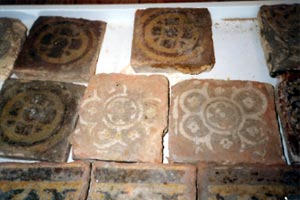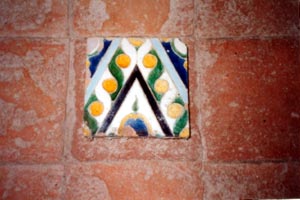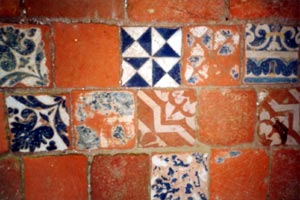
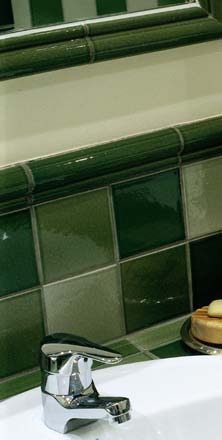
Historical Patrimony
HISTORY OF THE FAIENCES PAVING STONES IN"THE PAYS D'AUGE"
The first baked clay tiling stones appear in the 12th century in Europe. They replace the luxurious grounds of mosaic out of stone and marble, made of small juxtaposed cubes called "tesselles", spread thoughout the medieval world by Roman Antiquity. The important rise of construction at the 11th century, the exhaustion of the marble moanings and the low material cost first supported the emergence and success of these ceramic pavings which imitate the shapes and the colors of the old paving stones. This new technique, borrowed from the potters associates work ground the use of the lead-containing glaze, transparent vitrifiable coating which ensures the sealing of the paving stone and authorizes obtaining different colors. As archaeology attests it, the glaze is very old process which disappear as from the 5th century for reappear at the 9th century. It is introduced in Europe by Arabic and the cross ones who report remote regions these "majolica chatoyantes"(1) imitated soon by the potters of the country.
However one of discovered most original remains, without question, that of the stanniferous enamel which associates the lead-containing glaze a certain quantity of tin oxide. It results a white, consistent, opaque and glossed enamel from it, already used by Assyrian and Persians. Arab potters and Spanish of Majorque introduce them in Italy in the 13th century. Town of Faenza comes the appellation from "faïence" which will be given to the ceramics manufactured with this process. This stanniferous enamel is also used to decorate paving stones. The first faiences tilings appear as of the 13th century in Normandy, it is necessary to await the 16th century and creations of Masseot Abaquesne from Rouen to find paving stones faiences, mainly in the churches and the castles in the South and the North of France. But it is in "the Pays d'Auge", about in the middle of the 17th century which appear the first faiences squares truly original and emblematic. They are called "Joachim's tiles", of the name of their creator, Joachim Vattier, or faiences paving stones "of Lisieux" and are dedicated to a very great fame.
Potteries of "the Pays d'Auge" and Manerbe take in the 14th century a very important place in the ceramic production Low Norman. These workshops the thousands of the glaçurés paving stones, decorated many types of decorations stamped using a matrix and filled with a white slip leave(2). These paving stones are similar to those which are manufactured in many other medieval workshops.
In the middle of the 17th century that Joachim Vattier (born in 1620-22, died in 1709) lived in "the Pays d'Auge", state potter, Joachim Vattier's son, attested as sculptor in 1622, himself son of potter, began to manufacture paving stones, using a new technique, more elaborate than of the preceding illustrated paving stones. The paving stone is initially covered with a white slip. Then after a beginning of drying, the draft of the geometrical or floral decoration is engraved in this slip. After the first cooking, the paving stone is ready to receive its colors. The juxtaposition of enamels forms a mosaic which imitates art hispano-Moorish : "the enamel in fusion leaves inequalities, runouts, differences in tickness and consequently, of translucidity which revives the vibration of the colors. And like notices still the Etienne Deville, specialist on the matter at the beginning in this century. This manufacturing process underlines the Italian influence in "the Pré d'Auge" because it derives in right-hand side line paving stones Girolamo Della Robia, coming from the castle of Madrid to the Wood of Boulogne (1488-1556). The dominant colors are tender blue, supported blue, purple, yellow, green, chestnut wich are detached on a white zone are not engraved but undergo also two cookings. The reasons are generally distributed on a whole of 4 squares and offer broad compositions which are complementary edges, angles…
On the reverse, some of these paving stones could receive a stamped mark, which appears as a cross in four sheets. It is the mark which Joachim Vattier seems to have held for the paving stones choice.
These paving stones known as "of Lisieux" were hugely successful. With the difference of the glaçurés and non-faïencés paving stones of "the Pays d'Auge" and whole of the other centers of manufacture which one finds the model a little everywhere in France and Europe ; the faiences paving stones "Joachim" have as an originality this polychromy which is a regional singularity.
First of all, these paving stones are designed to decorate the Norman castles and manors but also in the religious buildings (churches, abbeys…) Etienne Deville enumerates a certain number of churches of "the Pays d'Auge" where he noticed, at the beginning of the century, the presence of pavings in squares "Joachim" : in "Monceaux", in "La Pommeray", in "Launay", in "Reux", in "Grandouet"(2) where one can observe the great diversity of the decorations and the care granted to the color.
Claude Lemaître adds to it abbey Saint Pierre sur Dives which sees in 1682 the ground of one of its vaults altered with flagstones limestones forming a cruciform decoration, supplemented of the whole of paving stones "of Lisieux" including polychrome been vermiculated paving stones manufactured by Joachim Vattier.
The church of the Pays d'Auge is not in remainder : to the 17th century, its interior decoration completely remade in paving stones "Joachim". As Claude Lemaître remarks in his study it on this subject, this work falls under the spirit of the religious alarm clock and of its expression in the rural churches of "the Pays d'Auge" to the 17th century.
In 1867, an architect "from Lisieux", Athème Pannier, noticed on behalf of the monumental statistics of the "Calvados" that emmarchement of furnace bridge of the septentrional vault was still decorated "of an enamelled landscape which appears to date from the reign of Louis XIV. The squares whose enamel is preserved perfectly, offer a bottom alternatively white and blue, decorated with rhombuses furnished with four yellow sheets ; on the white zone, the petals forming the four sheets are blue. In the lower angles flowers of lily take shape. All these paving stones are products of local industry.
Etienne Deville still specifies that the church of "the Pays d'Auge" of these furnace bridges had executed one by the potters of the 17th century. Pannier had found fragments in the bell-tower of the church and Mister de Mely had made a sketch of them. The bottom of the furnace bridge was made of vermiculated paving stones with multicoloured enamel, framed by pretty mouldings closed of a torus and listel. The front of the tomb was decorated with three medallions, of which two only still exist. The second-hand dealers of Lisieux, about 1880, dispersed these curious remainders…
In addition, Claude Lemaître suggests that in the church of "the Pays d'Auge", the ground could be entirely covered with paving stones "Joachim". Unfortunately almost none of this splendid decorative work remains today, only the pedestal of the statue of St Méen has escaped and still preserved this invaluable faiences paving stones manufactured by Joachim Vattier. Vattier occupies, during second half of the 17thcentury and the beginning of the 18th century an important social position in the parish of "the Pays d'Auge". In his marriage contract of September 27, 1689 with Marie Gosset, Joachim Vattier is designated as "sieur of Pré, maistre fayencier in squares."
He is buried in the church of "the Pays d'Auge" on December 12, 1709 et 87 years old, at the request of his wife and children.
The popularity of Joachim Vattier and its faiences paving stones does not stop at these regional borders but extends to places that appreciated his artistic creation.
Thus, its frame reaches Versailles, during 1670 and 1715, a considerable number of paving stones "of Lisieux" are delivered to decorate "Trianon de Porcelaine (destroyed in 1685) or the interior of the chimneys with the royal residence.
Only one of these brilliances squares remains with the library of Versailles (soma others are distributed in the museums of Cluny, Sevres and Cologne).
From 1692, the paving stones "of Lisieux" are provided by Branlard, faience manufacturer in Paris, which was to take them directly among Joachim Vattier or his successors. The use of the faïencé paving stone was appreciated by a lot of architects like Jules Hardouin Mansard. In the accounts of the buildings of the king, the paving stones called "squares" are enamelled, earthenware squares, squares "of Lisieux". Twelve thousand squares "of Lisieux" were also delivered to the Castle of Marly.
Initially in 1713, by Montreuil, inspector of the buildings of the king, who buys eight thousand of them ; then from January to April 1714, by Desjardin, controllers of the buildings of the king, who reserves four thousand of them.
The decorators of the field of Marly created for "a superb whim" of Louis IX, 1712 to 1714 the paving stones of "Joachim" to decorate in a very original way, "the basins of fayance" of the castle. Six basins are covered with polychrome enamelled squares : around the royal house, carp basins ; oneach side of the higher terrace, fountains of the nymphs. The coating of the fountain of Arthuse is also made pavin stones "of Lisieux".
Elsewhere from other squares come from the manufacture of "Saint Clous" who copies, on order, the shapes ond the reasons for the Norman paving stones. The deathe of the king in 1715 drew an end to his work. The vestiges of these squares are preserved at the Museum "promenade" of Marly-Le-Roi-Louveciennes who has a hundred fragments.
Bruno Bentz, who made a survey deepened on the faiences paving stones of the Castle of Marly, also brings back the following information : five series were found with, some, of the alternatives of texture, in the color of the glazes and of the reasons. The majority of the paving stones are square (11,5x11,5 cm). Some in rectangular (6x11,5 cm). Their thickness is variable (1,5 to 2 cm).
The fame of the squares of Lisieux lengthily survives their creator : in 1770, a certain "sieur Dumont" creates in Rouen a manufacture of paving stones "of Lisieux" which functions until the end of the 18th century.
At the same time, a "house of fayance", mentioned under this title
in the census of the marital status of 1816, is built with "the Pays
d'Auge" to promote the paving stone "of Lisieux" whose manufacture
and reputation persist.
Marie-Anne Leroy, of the family of Vattier resides at it. According to Mister
de Caumont, the frontage alone is covered floor tiles enamelled. The squares
placed between half-timberings date from the 17th century, the ones are decorated
with palms and are grouped by four to form a rosette.
Others, present a broad clouded edge blue and white. A cross in saltire decorates
an insulated paving stone.
According to the Abot Lefèvre, another "house of faience", that of Manor-farm of Broqueterie, was established at Vattier. It contained a room whose ground ond walls were entirely papered enamelled squares, surrounded by broad farmings of oak. This room was undoubtedly used as support to demonstrate to the customers of the potter of "the Pays d'Auge". With the end of the 19th, owner of this manor removes these paving stones to transport them to his castle of Thuit (the Eure). The paving stones remain before being attached to its death by Mr Montier, mayor of Pont Audemer, in 1902. Some are visible in the Museum of Lisieux (Musée du Vieux Lisieux).
Today after more than 300 years, the name of Vattier is still present in the regional memory of "the Pays d'Auge" even if it is not always associated the remarkable faiences paving stones.
The work of time , and especially that of the men, produced the work of the
"maistre fayencier". The historical value of the faiences paving
stones "Joachim" is further increased by their scarcity. Only some
squares, last pilot of this regional richness, remain here or there on some
privileged sites.



